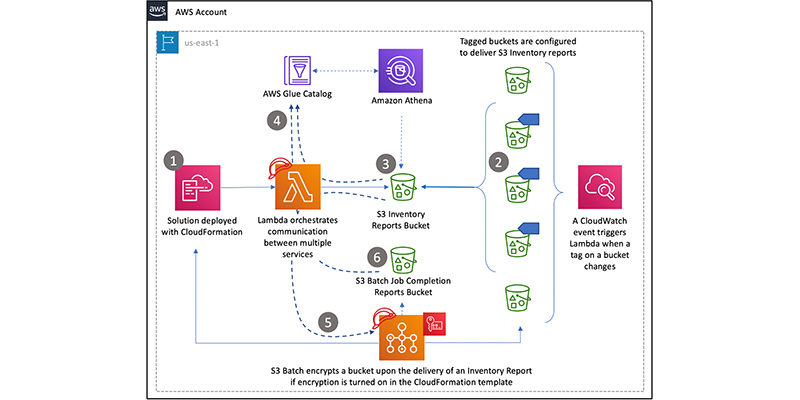AWS Security Blog
Category: Storage
Validate access to your S3 buckets before deploying permissions changes with IAM Access Analyzer
AWS Identity and Access Management (IAM) Access Analyzer helps you monitor and reduce access by using automated reasoning to generate comprehensive findings for resource access. Now, you can preview and validate public and cross-account access before deploying permission changes. For example, you can validate whether your S3 bucket would allow public access before deploying your […]
Updated whitepaper available: Encrypting File Data with Amazon Elastic File System
We’re sharing an update to the Encrypting File Data with Amazon Elastic File System whitepaper to provide customers with guidance on enforcing encryption of data at rest and in transit in Amazon Elastic File System (Amazon EFS). Amazon EFS provides simple, scalable, highly available, and highly durable shared file systems in the cloud. The file […]
Learn and use 13 AWS security tools to implement SEC recommended protection of stored customer data in the cloud
Most businesses collect, process, and store sensitive customer data that needs to be secured to earn customer trust and protect customers against abuses. Regulated businesses must prove they meet guidelines established by regulatory bodies. As an example, in the capital markets, broker-dealers and investment advisors must demonstrate they address the guidelines proposed by the Office […]
How to retroactively encrypt existing objects in Amazon S3 using S3 Inventory, Amazon Athena, and S3 Batch Operations
November 1, 2021: AWS KMS is replacing the term customer master key (CMK) with AWS KMS key and KMS key. The concept has not changed. To prevent breaking changes, AWS KMS is keeping some variations of this term. More info. Amazon Simple Storage Service (S3) is an object storage service that offers industry-leading scalability, performance, […]
Tighten S3 permissions for your IAM users and roles using access history of S3 actions
September 28, 2023: IAM is incrementally adding support for actions from more services. For a list of services that report action last accessed information, see IAM action last accessed information services and actions. Customers tell us that when their teams and projects are just getting started, administrators may grant broad access to inspire innovation and […]
IAM Access Analyzer flags unintended access to S3 buckets shared through access points
Customers use Amazon Simple Storage Service (S3) buckets to store critical data and manage access to data at scale. With Amazon S3 Access Points, customers can easily manage shared data sets by creating separate access points for individual applications. Access points are unique hostnames attached to a bucket and customers can set distinct permissions using […]
Continuously monitor unused IAM roles with AWS Config
January 6, 2021: We updated this post to fix a bug related to allow listing noncompliant roles. January 6, 2020: We updated this post to reflect a valid STS session duration if configured to assume a role into other accounts. Developing in the cloud encourages you to iterate frequently as your applications and resources evolve. […]
Now You Can Create Encrypted Amazon EBS Volumes by Using Your Custom Encryption Keys When You Launch an Amazon EC2 Instance
October 29, 2021: AWS KMS is replacing the term customer master key (CMK) with AWS KMS key and KMS key. The concept has not changed. To prevent breaking changes, AWS KMS is keeping some variations of this term. More info. Amazon Elastic Block Store (EBS) offers an encryption solution for your Amazon EBS volumes so […]
How to Use Bucket Policies and Apply Defense-in-Depth to Help Secure Your Amazon S3 Data
Amazon S3 provides comprehensive security and compliance capabilities that meet even the most stringent regulatory requirements. It gives you flexibility in the way you manage data for cost optimization, access control, and compliance. However, because the service is flexible, a user could accidentally configure buckets in a manner that is not secure. For example, let’s […]
How to Encrypt Amazon S3 Objects with the AWS SDK for Ruby
August 31, 2021: AWS KMS is replacing the term customer master key (CMK) with AWS KMS key and KMS key. The concept has not changed. To prevent breaking changes, AWS KMS is keeping some variations of this term. More info. Recently, Amazon announced some new Amazon S3 encryption and security features. The AWS Blog post […]









